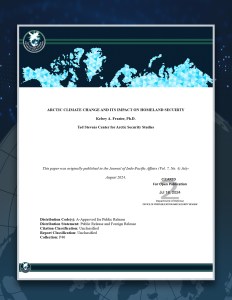This paper examines the multifaceted implications of changing environmental conditions in the Arctic for U.S. national security, highlighting both the challenges and opportunities these transformations present. As diminishing sea ice, altered wave dynamics, increased wind speeds, and emerging weather phenomena such as rogue waves and intensified lightning reshape the Arctic landscape, the need for adaptive strategies, enhanced surveillance, and robust infrastructure resilience becomes paramount. The analysis underscores the importance of leveraging technological advancements and fostering international collaboration to navigate the operational risks and strategic complexities resulting from the Arctic’s evolving climate. It also explores the economic potentials unlocked by new maritime routes and the access to untapped natural resources, advocating for sustainable and cooperative approaches to regional development. Through a comprehensive examination of the dynamic Arctic environment, this paper emphasizes the United States’ pivotal role in promoting security, stability, and prosperity in the region, advocating for a proactive, informed, and collaborative approach to ensure a resilient, sustainable, and beneficial future for the Arctic and its stakeholders.

